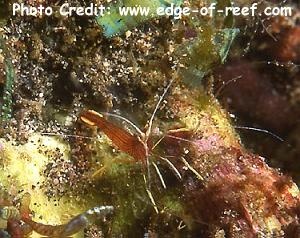
By Bob Goemans


Likely Reef Tank Suitable
Likely Fish-Only Tank Suitable
One of the more valuable and interesting crustaceans/shrimp are those that participate in the phenomenon of a cleaning symbiosis. This event involves the removal of parasites and other matter from various body parts of the infested fish, all in the name of a square meal. Their grooming/cleaning habits include climbing into the mouth of fish, cleaning the teeth and gill area, and/or picking small pieces of diseased flesh/bacteria from along the sides of the fish.
To signal the willingness of the shrimp to perform the cleaning ritual they perform either a rocking motion or swaying of their antennae and/or front legs. Since community aquariums sometimes contain large fishes like angelfish, triggerfish, etc., which in turn like to eat shrimp, having both together in the same aquarium is a chancy situation, especially where the shrimp is concerned. Even placing shrimp in the reef aquarium, where fish species are usually less aggressive, is still chancy. Not chancy for the shrimp, but chancy for other invertebrate, as some shrimps have a tendency to pick on corals and anemones. Yet, if you want to keep shrimp, the best habitat is that of a reef tank.
A question that arises every so often is what types of cleaner shrimp can be safely kept together in the same aquarium. Of the three most common, i.e., Lysmata, Periclimenes, and Stenopus, only the L. amboinensis and L. grabhami would be recommended as being safe to keep together in the same 'average size' aquarium. Even then, sufficient hiding places and a good supply of food is necessary to keep them from consuming each other. In larger aquaria with many hiding places and a good supply of food, different species can be maintained in the same environment.
As for molting in general, i.e., the shedding of its shell-like exterior (exoskeleton), it's an extremely important growth aspect for all shrimp. To grow larger, shrimp must shed this exoskeleton, as it will not stretch. Periodically, the shell-like covering begins to dissolve and separates from the body tissue while a new shell develops underneath. When the process completes, the shrimp climbs out of the old exterior covering and then takes up water, stretching the new soft covering to fit its now larger body. When finished, the new covering forms a hard exoskeleton. Keep in mind they are defenseless at molting time, therefore need secure hiding places that predators cannot reach.
All shrimp should be slowly acclimated to their new surroundings as they have a tendency to go into shock when entering an aquarium where water parameters are only slightly different from the shipping container. Temperature and especially Specific Gravity (S.G.) should be the same before transferring them into their permanent home. Contrary to what you may have heard, shrimp of any kind should never be given a freshwater bath to kill parasites prior to being added to the aquarium. It 'will' kill them, as they are very sensitive to changes in osmotic pressure. And as with all shrimp, low alkalinity, calcium, iodine and especially low magnesium levels can interfere with the molting process. In fact, magnesium 'must' be maintained at the proper level in relation to the S.G., or the molting process will not complete (Dr. Vincent Hargreaves, pers. com.). The lack of proper magnesium level is probably the main reason why many aquarists fail to maintain shrimp over the long term!
There are other pretty members in different genera in this family, some which can be trusted, others that cannot (such as those in the genus Saron) and those that should be left in the wild.